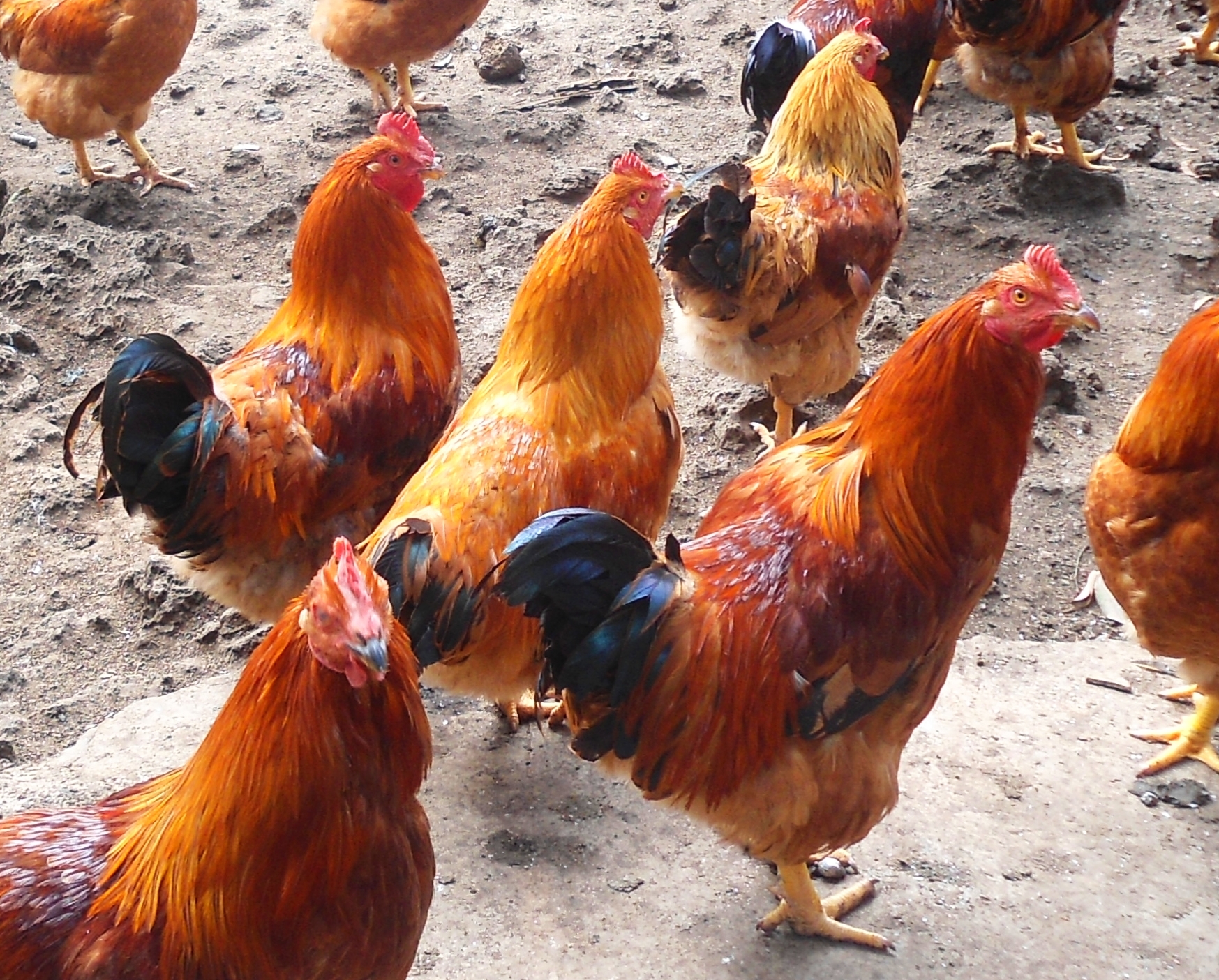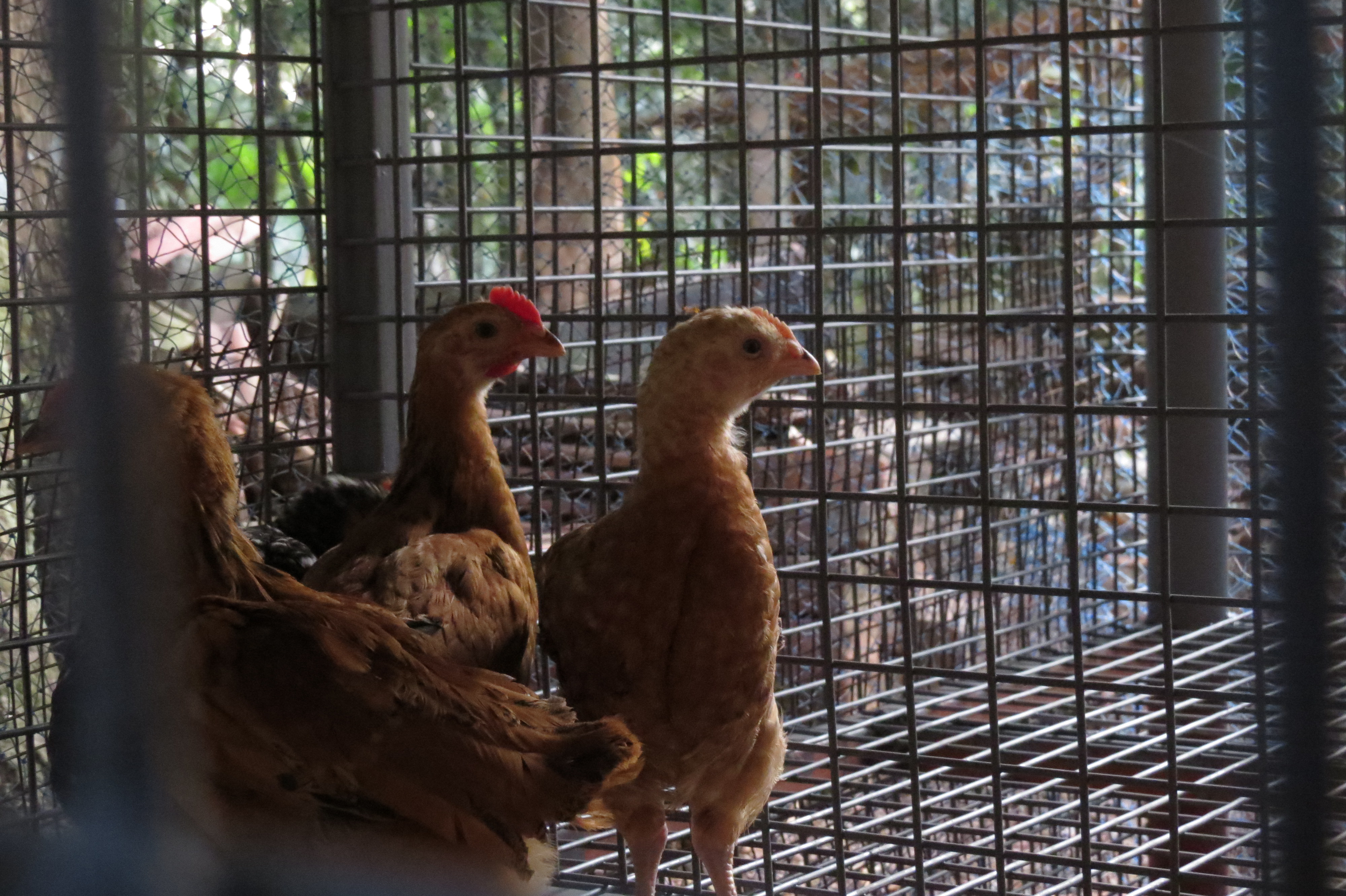|
Slovenian Brown Hen
Slovenian Brown Hen () is a traditional breed of domestic chicken, originating in Slovenia.Slovenske avtohtone in tradicionalne pasme domačih živali (2014). Oddelek za zootehniko, UL BF (in Slovenian). Retrieved 18.11.2021. It was developed at the end of the 20th century at the Biotechnical Faculty of University of Ljubljana. Animals of this breed are brown coloured layer hens that are also used as parents for commercial [...More Info...] [...Related Items...] OR: [Wikipedia] [Google] [Baidu] |
Chicken
The chicken (''Gallus gallus domesticus'') is a domestication, domesticated junglefowl species, with attributes of wild species such as the grey junglefowl, grey and the Ceylon junglefowl that are originally from Southeastern Asia. Rooster or cock is a term for an adult male bird, and a younger male may be called a cockerel. A male that has been castrated is a capon. An adult female bird is called a hen and a sexually immature female is called a pullet. Humans now keep chickens primarily as a source of food (consuming both their Chicken as food, meat and egg as food, eggs) and as pets. Traditionally they were also bred for cockfighting, which is still practiced in some places. Chickens are one of the most common and widespread domestic animals, with a total population of 23.7 billion , up from more than 19 billion in 2011. There are more chickens in the world than any other bird. There are numerous cultural references to chickens – in myth, folklore and religion, and in la ... [...More Info...] [...Related Items...] OR: [Wikipedia] [Google] [Baidu] |
Plumage
Plumage ( "feather") is a layer of feathers that covers a bird and the pattern, colour, and arrangement of those feathers. The pattern and colours of plumage differ between species and subspecies and may vary with age classes. Within species, there can be different colour morphs. The placement of feathers on a bird is not haphazard, but rather emerge in organized, overlapping rows and groups, and these are known by standardized names. Most birds moult twice a year, resulting in a breeding or ''nuptial plumage'' and a ''basic plumage''. Many ducks and some other species such as the red junglefowl have males wearing a bright nuptial plumage while breeding and a drab ''eclipse plumage'' for some months afterward. The painted bunting's juveniles have two inserted moults in their first autumn, each yielding plumage like an adult female. The first starts a few days after fledging replacing the ''juvenile plumage'' with an ''auxiliary formative plumage''; the second a month o ... [...More Info...] [...Related Items...] OR: [Wikipedia] [Google] [Baidu] |
Meat
Meat is animal flesh that is eaten as food. Humans have hunted, farmed, and scavenged animals for meat since prehistoric times. The establishment of settlements in the Neolithic Revolution allowed the domestication of animals such as chickens, sheep, rabbits, pigs, and cattle. This eventually led to their use in meat production on an industrial scale in slaughterhouses. Meat is mainly composed of water, protein, and fat. It is edible raw but is normally eaten after it has been cooked and seasoned or processed in a variety of ways. Unprocessed meat will spoil or rot within hours or days as a result of infection with, and decomposition by, bacteria and fungi. Meat is important to the food industry, economies, and cultures around the world. There are nonetheless people who choose to not eat meat ( vegetarians) or any animal products ( vegans), for reasons such as taste preferences, ethics, environmental concerns, health concerns or religious dietary rules. Terminolog ... [...More Info...] [...Related Items...] OR: [Wikipedia] [Google] [Baidu] |
Capon
A capon (from la, cāpō, genitive ''cāpōnis'') is a cockerel (rooster) that has been castrated or neutered, either physically or chemically, to improve the quality of its flesh for food, and, in some countries like Spain, fattened by forced feeding. History The origins of caponised chickens are contested. They were known in ancient China as well as in ancient Greece and ancient Rome. An early record of caponisation is found under the Roman Republic: the Lex Faunia of 162 BC forbade fattening hens to conserve grain rations, so the Romans instead castrated roosters, which resulted in a doubling of size. It was also practiced later throughout medieval times, with gastronomic texts describing capons as preferred poultry since the ordinary fowl of the farmyard was regarded as peasant fare and "popular malice crediting monks with a weakness for capons." France is internationally renowned for maintaining a strong caponisation tradition with widespread and established indu ... [...More Info...] [...Related Items...] OR: [Wikipedia] [Google] [Baidu] |
Prelux-Č
Prelux are commercial chicken crossbreeds of the Slovenian origin, that are being sold under the eponymous trademark by the Biotechnical Faculty of University of Ljubljana. The name is an abbreviation for the Slovenian phrase ''prevojski luxuriranci'', with a word ''luxuriranci'' referring to luxuriance (heterosis) or outbreeding enhancement of hybrid offspring,Selekcija kokoši za potrebe manjših rej v Sloveniji (2015). Dušan Terčič, BF UL Oddelek za zootehniko (in Slovenian). Retrieved 14.11.2021. and adjective ''prevojski'' referring to the Slovenian settlement , where selective breeding was once performed. [...More Info...] [...Related Items...] OR: [Wikipedia] [Google] [Baidu] |
Eggshell
An eggshell is the outer covering of a hard-shelled egg and of some forms of eggs with soft outer coats. Diversity Worm eggs Nematode eggs present a two layered structure: an external vitellin layer made of chitin that confers mechanical resistance and an internal lipid-rich layer that makes the egg chamber impermeable. Insect eggs Insects and other arthropods lay a large variety of styles and shapes of eggs. Some of them have gelatinous or skin-like coverings, others have hard eggshells. Softer shells are mostly protein. It may be fibrous or quite liquid. Some arthropod eggs do not actually have shells, rather, their outer covering is actually the outermost embryonic membrane, the choroid, which serves to protect inner layers. The choroid itself can be a complex structure, and it may have different layers within it. It may have an outermost layer called an ''exochorion''. Eggs which must survive in dry conditions usually have hard eggshells, made mostly of dehydrated ... [...More Info...] [...Related Items...] OR: [Wikipedia] [Google] [Baidu] |
Egg As Food
Humans and human ancestors have scavenged and eaten animal eggs for millions of years. Humans in Southeast Asia had domesticated chickens and harvested their eggs for food by 1,500 BCE. The most widely consumed eggs are those of fowl, especially chickens. Eggs of other birds, including ostriches and other ratites, are eaten regularly but much less commonly than those of chickens. People may also eat the eggs of reptiles, amphibians, and fish. Fish eggs consumed as food are known as roe or caviar. Bird and reptile eggs consist of a protective eggshell, albumen ( egg white), and vitellus ( egg yolk), contained within various thin membranes. Egg yolks and whole eggs store significant amounts of protein and choline, and are widely used in cookery. Due to their protein content, the United States Department of Agriculture formerly categorized eggs as ''Meats'' within the Food Guide Pyramid (now MyPlate). Despite the nutritional value of eggs, there are some potential healt ... [...More Info...] [...Related Items...] OR: [Wikipedia] [Google] [Baidu] |
Free Run (animal)
Free run is a method of farming stewardship where the animals are not kept in cages but are allowed to wander around inside an enclosed structure, such as a barn. Unlike free range animals they do not have access to the outside. It is just cheaper than free range, but it is not looked upon as highly as by those concerned about animal welfare. See also * Free Range * Ethical consumerism * Moral purchasing Ethical consumerism (alternatively called ethical consumption, ethical purchasing, moral purchasing, ethical sourcing, or ethical shopping and also associated with sustainable and green consumerism) is a type of consumer activism based on the conc ... References {{DEFAULTSORT:Free Run Animal welfare Livestock ... [...More Info...] [...Related Items...] OR: [Wikipedia] [Google] [Baidu] |
Poultry Litter
In agriculture, poultry litter or broiler litter is a mixture of poultry excreta, spilled feed, feathers, and material used as bedding in poultry operations. This term is also used to refer to unused bedding materials. Poultry litter is used in confinement buildings used for raising broilers, turkeys and other birds. Common bedding materials include wood shavings, sawdust, peanut hulls, shredded sugar cane, straw, and other dry, absorbent, low-cost organic materials. Sand is also occasionally used as bedding. The bedding materials help absorb moisture, limiting the production of ammonia and harmful pathogens. The materials used for bedding can also have a significant impact on carcass quality and bird performance. There are specific practices that must be followed to properly maintain the litter and maximize the health and productivity of the flocks raised on it. Many factors must be considered in successful litter management including time of the year, depth of the litter, floo ... [...More Info...] [...Related Items...] OR: [Wikipedia] [Google] [Baidu] |
Furnished Cage
A furnished cage, sometimes called enriched cage, colony cage or modified cage, is a type of cage used in poultry farming for egg laying hens. Furnished cages have been designed to overcome some of the welfare concerns of battery cages (also called 'conventional' or 'traditional cages') whilst retaining their economic and husbandry advantages, and also provide some of the welfare advantages over non-cage systems. Many design features of furnished cages have been incorporated because research in animal welfare science has shown them to be of benefit to the hens. History and legislation Battery cages have already banned in several countries including all European Union member states (since 2012 under European Union Council Directive 1999/74/EC), Norway (since 2012) and Switzerland (since 1992). New Zealand New Zealand ( mi, Aotearoa ) is an island country in the southwestern Pacific Ocean. It consists of two main landmasses—the North Island () and the South Island ()� ... [...More Info...] [...Related Items...] OR: [Wikipedia] [Google] [Baidu] |






(NRCS_Photo_Gallery).jpg)
